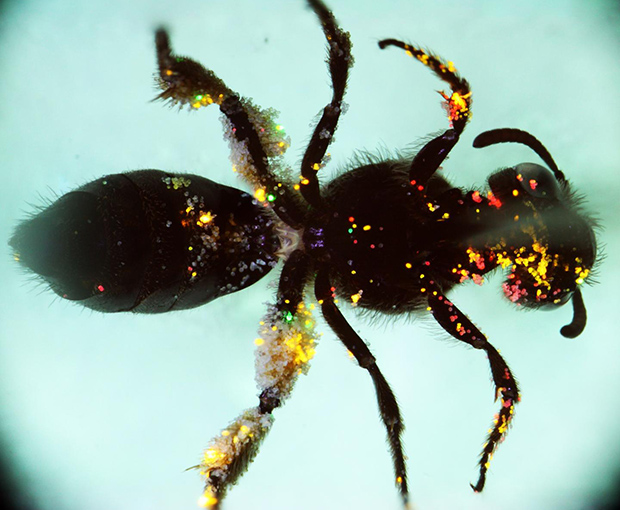Researchers at Stellenbosch University in South Africa have found a way to track pollen using quantum dots, developing a simple and cost-effective method for studying pollen distribution.
Cassie Sims
Pollination and pollination services are key for productive farming. In fact, many farms actively manage pollination, bringing in bees or planting effective field margins. Despite the importance of pollination, for many years research has been limited as there is no efficient way to study pollen distribution or track individual pollen grains.
Scientists at Stellenbosch University, South Africa, have developed an innovative method to track pollen using quantum dots. Quantum dots are nanocrystals that emit bright fluorescent light when exposed to UV light. The quantum dots were equipped with lipophilic (fat-loving) ligands to allow them to stick to the fatty outer layer of pollen grains. The fluorescent colour of the quantum dots can then be used to track any pollen they have adhered to.
Bee was caught after it visited a flower of which the pollen grains were labelled with quantum dots. Image: Corneile Minnaar
‘Most plant species on earth are reliant on insects for pollination, including more than 30% of the food crops we eat. With insects facing rapid global decline, it is crucial that we understand which insects are important pollinators of different plants – this starts with tracking pollen,’ said Dr Corneile Minnaar, Postdoctoral Fellow at Stellenbosch and first author of the study.
After successfully labelling the pollen, the next step was to design a cheap and effective method to view the fluorescent pollen grains under a field dissection microscope. Initially, Minnaar used a small UV LED light on a toy pen from a family restaurant.
‘I decided to design a fluorescence box that can fit under a dissection microscope. And, because I wanted people to use this method, I designed a box that can easily be 3D-printed at a cost of about R5,000, including the required electronic components,’ adds Minnaar.
Tracking pollen with quantum dots. Image: Stellenbosch University
The method has proven to be successful in tracking individual pollen grains so far, despite the meticulous pollen counting work that is required. The scientists are already using the methodology for finding new information about the distribution of pollen.
‘I've done studies where I caught the insects after they have visited the plant with quantum-dot labelled anthers, and you can see where the pollen is placed, and which insects actually carry more or less pollen.’
It is hoped that this method could be used to improve studies in pollen distribution and find solutions to many unanswered questions in the field.
DOI:10.1111/2041-210X.13155

